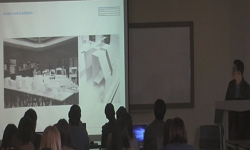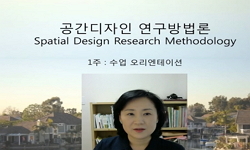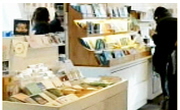(연구배경 및 목적) 산업 사회로부터 정보화 사회로 이행함에 따라, 공간 디자인의 패러다임도 변화되었다. 과거의 공간 디자인은 유형의 디자인 요소와 시각적 디자인에 집중하였다면, 최...
http://chineseinput.net/에서 pinyin(병음)방식으로 중국어를 변환할 수 있습니다.
변환된 중국어를 복사하여 사용하시면 됩니다.
- 中文 을 입력하시려면 zhongwen을 입력하시고 space를누르시면됩니다.
- 北京 을 입력하시려면 beijing을 입력하시고 space를 누르시면 됩니다.

백화점 공용 공간의 사용자 경험(UX) 디자인 특성 연구 -MZ 세대 소비자 평가를 중심으로- = A Study on Characteristics of User Experience(UX) Design in Public Spaces of Department Stores -Focused on MZ Generation Consumer’s Evaluation-
한글로보기https://www.riss.kr/link?id=A107999297
- 저자
- 발행기관
- 학술지명
- 권호사항
-
발행연도
2021
-
작성언어
-
-
주제어
Department store ; Public space ; Space design ; User experience(UX) ; MZ generation ; 백화점 ; 공용 공간 ; 공간 디자인 ; 사용자 경험(UX) ; MZ 세대
-
등재정보
KCI등재
-
자료형태
학술저널
- 발행기관 URL
-
수록면
86-98(13쪽)
-
KCI 피인용횟수
0
- DOI식별코드
- 제공처
-
0
상세조회 -
0
다운로드
부가정보
국문 초록 (Abstract)
(연구배경 및 목적) 산업 사회로부터 정보화 사회로 이행함에 따라, 공간 디자인의 패러다임도 변화되었다. 과거의 공간 디자인은 유형의 디자인 요소와 시각적 디자인에 집중하였다면, 최근의 공간 디자인은 공간의 사용성, 기능성, 편의성, 친환경성 등을 진작하고, 사용자들의 정서적 안정감, 행복감, 만족감을 지각시키는 무형의 디자인 요소 및 디자인과 인간의 연결·조화 등을 더욱 중시하는 경향을 보여준다(Lee, 2017). 이를 고려하면, 현재와 미래의 백화점 공용 공간은 사용자들의 개별적·개성적 니즈(needs)와 취향, 기대에 부응하면서 뜻깊은 체험과 추억을 제공하는 동시에, 인간과 공간 간의 원활한 커뮤니케이션과 상호 작용이 진행되는 감성적, 정서적 장소로 진화되어야 한다. 이러한 시대적 요구와 흐름에 능동적으로 대처하기 위해서는, 보다 많은 사용자들의 니즈와 감성을 맞춤형으로 충족시킬 수 있는 ‘사용자 경험(User eXperience. UX) 중심의 백화점 공간 디자인’이 요구된다. (연구방법) 이를 위해, 본 연구는 ‘백화점 공용 공간의 사용자 경험 중심 디자인 특성’을 도출하고, 그에 대한 ‘MZ 세대’ 사용자들의 평가와 반응을 문헌 고찰, 현장 조사, 설문 조사의 혼합 연구 방식을 활용하여 조사·분석하였다. 첫째, 백화점 공용 공간의 의미, 기능, 특징, UX 디자인의 개념과 특징 등에 대한 문헌 고찰을 수행하였다. 둘째, 서울 소재 G백화점 명품관을 대상으로 공간 디자인 사례 조사를 진행하였다. 셋째, 백화점 공용 공간의 UX 디자인 특성과 세부 요인들을 도출하고, MZ 세대 사용자 대상 설문 조사를 수행하였다. (결과) 본 연구의 주요 결과는 다음과 같다. 첫째, 문헌 고찰을 통해, 백화점 공용공간의 UX 디자인 특성 요인으로서 연상성, 역동성, 이벤트성, 감각 자극성, 상호 작용성의 5개 요인을 도출하였다. 사용자 경험 디자인이 적용된 백화점 공용 공간은 백화점 이용 과정 및 백화점 내에서 진행되는 각종 활동, 행위들에 대한 긍정적인 기억과 감성 체험 등을 연상하도록 유도하고(연상성), 소비자들의 능동적, 자율적 활동과 필수적, 선택적 행동들을 사용자 친화적으로 수용하고 피드백하며(역동성), 다양한 유희적, 감각적 자극이나 특별 활동, 다채로운 행사들을 체험·참여할 수 있도록 유도하고 (이벤트성), 사용자들의 오감을 자극하여 직접적·입체적 체험과 참여, 각종 활동을 촉진하며(감각 자극성), 이를 토대로 공간과 인간 사용자 간의 긴밀한 교류, 공감, 커뮤니케이션 등을 보장하고 지원할 수 있다(상호 작용성). 둘째, MZ 세대 소비자들에 대한 설문 조사 분석 결과, MZ 세대 소비자들은 백화점 공용 공간의 UX 디자인 특성에 대해 감각 자극성 > 역동성 > 상호 작용성> 연상성 > 이벤트성의 순서로 의미 있게 지각하는 것으로 나타났다. (결론) 이 같은 결과를 토대로, 감각적, 감성적인 젊은 세대 소비자들의 체험과 기억, 공간과의 교감, 상호 작용 등을 질적으로 향상시키기 위해서는, 그들의 섬세하고 능동적인 심리, 행동, 니즈, 기대 등을 선제적, 진보적, 개방적으로 반영·수용하고 피드백함으로써, 그들의 향상된 체험과 감성적, 정서적 만족을 적극 유도·촉진하는 미래 지향적 공간 경험 디자인 전략을 개발·모색할 당위성, 필요성을 최종 확인하였다. 이 같은 본 연구의 결과가 사용자 경험을 심도 있게 반영한 사용자 친화적, 사용자 중심적인 백화점 공용 공간을 구성하고 디자인하는 데 도움이 되는 유효한 이론적, 실무적 지침으로 활용되기를 기대한다.
다국어 초록 (Multilingual Abstract)
(Research background and purpose) The paradigm of space design has changed recently as the industrial society has switched to the information society. Whereas space design in the past focused on tangible design elements and visual design, recent space...
(Research background and purpose) The paradigm of space design has changed recently as the industrial society has switched to the information society. Whereas space design in the past focused on tangible design elements and visual design, recent space design promotes usability, functionality, convenience, and eco-friendliness of space, giving more importance to intangible design elements that perceive the emotional stability, happiness, and user satisfaction. Considering this, the common spaces of department stores require meaningful experiences and memories that conform to individual needs, tastes, and expectations of users, while simultaneously providing space for smooth communication and interaction between humans and spaces. To actively respond to these demands and trends of the times, 'UX(User eXperience)-centered department store space design' capable of meeting the needs and sensibility of more users is required. (Method) This study derived UX-oriented design characteristics of public spaces in department stores' and analyzed the evaluation and reaction of MZ generation users using a mixed research method of literature review, field research, and survey. First, a literature review was conducted on the meaning, function, and characteristics of the UX design of public spaces. Second, a spatial design case study was conducted on the luxury hall of a G-department store in Seoul. Third, the UX design characteristics and sub-factors of public spaces were derived, and a survey was conducted for users of the MZ generation. (Results) The main results of this study are as follows: First, through a literature review, association, dynamism, event, sensory stimulation, and interactivity were derived as UX design characteristic factors. User experience design improves and enhances users' emotional experience, self-directed experience, unique value perception, sensory pleasure, and emotional well-being as a whole through smooth communication, connection, interaction, and sympathy between the environment and users. Based on this, it is expected to contribute to shopping satisfaction and improve brand preference and affinity for department stores. Second, to confirm the meaningful value and useful functions of UX design characteristics, this study conducted a questionnaire survey targeting MZ generation consumers who actively pursue emotional and individual consumption and their own value experiences. The analysis showed that consumers in the MZ generation perceived the UX design characteristics of department store public spaces meaningfully in the order of sensory stimulation > dynamism > interactivity > associativity > event, but the degree of perception was rather lukewarm. (Conclusion) A future-oriented space experience design strategy that actively promotes improved experiences and satisfaction was developed. It is expected that the results of this study will be used as valid theoretical and practical guidelines to help construct and design user-friendly, user-centred department store public spaces.
참고문헌 (Reference)
1 Statistics Korea, "통계로 보는 MZ 세대트렌드 [Statistics on MZ generation trends]"
2 박정순, "제품의 사용자 경험과 디자인 : 제품의 사용자경험에 대한 실증적 연구" 한국학술정보 2012
3 본지페, 구이, "인터페이스 : 디자인에대한 새로운 접근" 시공사 2003
4 조성봉, "이것이 UX 디자인이다" 위키북스 2013
5 박혜숙, "신세대 특성과 라이프 스타일 연구 - Z세대를 중심으로 -" 사단법인 아시아문화학술원 7 (7): 753-767, 2016
6 박선명, "시선추적을 이용한 선택적 시각탐색에 대한 기초적 연구 - 백화점매장 공간 이미지를 중심으로 -" 한국실내디자인학회 24 (24): 125-133, 2015
7 박동, "소비자 특성에 따른 백화점 실내휴게공간 이용행태와 인식 -서울지역 소비자 군집유형을 중심으로-" 한국공간디자인학회 14 (14): 171-182, 2019
8 문재승, "사용자경험과 서비스 변화" 커뮤니케이션북스 2015
9 구선아, "사용자 중심의 경험공간을 위한 어포던스디자인 적용에 관한 연구" 서울시립대학교 디자인전문대학원 2011
10 모조설, "사용자 분석에 의한 패밀리레스토랑의 UX디자인 특성" 한국공간디자인학회 14 (14): 155-165, 2019
1 Statistics Korea, "통계로 보는 MZ 세대트렌드 [Statistics on MZ generation trends]"
2 박정순, "제품의 사용자 경험과 디자인 : 제품의 사용자경험에 대한 실증적 연구" 한국학술정보 2012
3 본지페, 구이, "인터페이스 : 디자인에대한 새로운 접근" 시공사 2003
4 조성봉, "이것이 UX 디자인이다" 위키북스 2013
5 박혜숙, "신세대 특성과 라이프 스타일 연구 - Z세대를 중심으로 -" 사단법인 아시아문화학술원 7 (7): 753-767, 2016
6 박선명, "시선추적을 이용한 선택적 시각탐색에 대한 기초적 연구 - 백화점매장 공간 이미지를 중심으로 -" 한국실내디자인학회 24 (24): 125-133, 2015
7 박동, "소비자 특성에 따른 백화점 실내휴게공간 이용행태와 인식 -서울지역 소비자 군집유형을 중심으로-" 한국공간디자인학회 14 (14): 171-182, 2019
8 문재승, "사용자경험과 서비스 변화" 커뮤니케이션북스 2015
9 구선아, "사용자 중심의 경험공간을 위한 어포던스디자인 적용에 관한 연구" 서울시립대학교 디자인전문대학원 2011
10 모조설, "사용자 분석에 의한 패밀리레스토랑의 UX디자인 특성" 한국공간디자인학회 14 (14): 155-165, 2019
11 김세영, "사용자 경험을 위한 인터랙션 공간디자인 표현에 관한 연구- 디지털 미디어를 중심으로 -" 한국실내디자인학회 21 (21): 48-56, 2012
12 차두원, "사용자 경험(User eXperience) : 인간 중심 IT 정책 추진을 위한 제언" 정보통신산업진흥원 2011
13 이진이, "사용자 경험 디자인에서 사용자의 자아개념에 관한 연구" 한국디자인문화학회 22 (22): 323-337, 2016
14 이재은, "백화점 실내외 휴게공간 환경특성 및 이용만족도에 관한 연구" 한국실내디자인학회 29 (29): 27-39, 2020
15 최계영, "백화점 매장공간의 성별 탐색 특성과 주시경향에 관한 연구" 한국실내디자인학회 25 (25): 52-60, 2016
16 강원배, "백화점 공용 공간 비주얼 머천다이징에 관한 연구 -부산 센텀시티점을 중심으로-" 한국디자인학회 23 (23): 5-14, 2010
17 김주희, "미래사용자 경험디자인 : 디지털 사이니지와스마트 미디어 제작사례" 팝사인 2013
18 강훈, "디지털·디자인·건축" 비온후 2005
19 김진우, "경험디자인-잡스, 철학자 듀이를 만나다" 안그라픽스 2014
20 이태희, "감성소비행동분석론" 백산 2014
21 Rosenberg, D., "The Business of UX Strategy" 25 (25): 26-32, 2018
22 Jeong, Seungeun, "Relationships between Flexible Display's Form Factors and its User Experience Types for User Experience Design" Ewha University Graduate School 2015
23 Oh, S., "Pay attention to the Z generation" 52 (52): 57-62, 2018
24 Park, Jooyeon, "Effects of Interaction with Interface Agents on Psychological Experiences of Users: Based on Types of Conversation and Users'Personality" 2007 (2007): 1640-1647, 2007
25 Kato, T., "Contribution of concept recall to brand loyalty: An empirical analysis of design and performance" 2021
26 Kim, Seungmin, "Communication Focused UX Design Paradigm : Based on Using Behavior of Mobile Information Technology Equipment" Seoul National University Graduate School 2012
27 Battarbee, K, "Co-experience : Understanding user experiences in social interaction" University of Art and Design Helsinki 2004
28 Park, Yeonjung, "A study on the role of department store as regional facilities" Seoul National University Graduate School 2014
29 Kang, Ayoung, "A study on the property that affects the formation of the value based on the user experience : focused on user experience at the coffee shop" Chungang University Graduate School 2019
30 Lee, Minah, "A study of servicescape power index based on spatial user experience design: focused on physical evidence of cultural art space" Hongik University Graduate School 2017
31 Lee, Sujin, "A Study on the interior space in tour information center adapted to the user experience design" Hongik University Graduate School 2011
32 Choi, Bokyung, "A Study on the family restaurant space design of focused on user experience" Hongik University Graduate School 2014
33 Lee, Kyungeun, "A Study on Corporate Space Marketing through User Experience Design" Hanyang University Graduate School 2013
34 Lee, Jaehoon, "2020년을 주도할 밀레니얼 Z세대의 트렌드 [Millenial-Z generation trend for 2020]" 265 : 14-17, 2019
동일학술지(권/호) 다른 논문
-
실감 콘텐츠의 체험적 특성 요소에 관한 연구 - HMD와 3면 Virtual Reality Surround-Screen Projection System을 중심으로 -
- 한국공간디자인학회
- 박주현 ( Park Joohyun )
- 2021
- KCI등재
-
도시경쟁력 구축을 위한 우수 공공시설물 디자인 인증제 연구
- 한국공간디자인학회
- 김국선 ( Kim Kooksun )
- 2021
- KCI등재
-
- 한국공간디자인학회
- 장주영 ( Chang Jooyoung )
- 2021
- KCI등재
-
체험마케팅을 적용한 메종 플래그십 스토어의 공간 표현특성에 관한 연구
- 한국공간디자인학회
- 이목영 ( Lee Mokyoung )
- 2021
- KCI등재
분석정보
인용정보 인용지수 설명보기
학술지 이력
| 연월일 | 이력구분 | 이력상세 | 등재구분 |
|---|---|---|---|
| 2022 | 평가예정 | 재인증평가 신청대상 (재인증) | |
| 2019-01-01 | 평가 | 등재학술지 유지 (계속평가) |  |
| 2016-01-01 | 평가 | 등재학술지 선정 (계속평가) |  |
| 2015-06-01 | 학술지명변경 | 외국어명 : Journal of the Korea Intitute of the spatial design -> Journal of Korea Intitute of Spatial Design |  |
| 2015-01-01 | 평가 | 등재후보학술지 유지 (계속평가) |  |
| 2013-01-01 | 평가 | 등재후보 1차 FAIL (등재후보1차) |  |
| 2012-01-01 | 평가 | 등재후보학술지 유지 (기타) |  |
| 2011-01-01 | 평가 | 등재후보 1차 PASS (등재후보1차) |  |
| 2009-01-01 | 평가 | 등재후보학술지 선정 (신규평가) |  |
학술지 인용정보
| 기준연도 | WOS-KCI 통합IF(2년) | KCIF(2년) | KCIF(3년) |
|---|---|---|---|
| 2016 | 0.47 | 0.47 | 0.53 |
| KCIF(4년) | KCIF(5년) | 중심성지수(3년) | 즉시성지수 |
| 0.51 | 0.52 | 0.692 | 0.28 |





 KCI
KCI KISS
KISS






